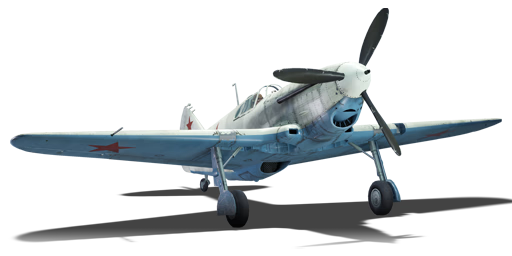

Aviation
LaGG-3-8
II
Rank
AB
2.3
RB
2.0
SB
2.0
Battle rating
USSR
Game nation
Fighter
Main role
7,900

Research
10,000

Purchase
General information
Flight performance
Max speed
at 5,000 m
554514577532 km/h
Rate of Climb
10.57.6147.6 m/s
Turn time
2426.322.825.2 s
Max altitude
9,000 m
Takeoff Run
400 m
Landing
flaps
flaps
Take-off
flaps
flaps
Combat
flaps
flaps
Air
brake
brake
General characteristics
Crew
1 person
Engine
Length
8.8 m
Wingspan
9.8 m
Wing Loading
191 kg/m²
Weight:
Base weight
3.023.112.943.1 t
Fuel in main tanks
0.35 t (1h 13m)
Limits:
Max Speed Limit (IAS)
700 km/h
Mach Number Limit
0.8 M
G limit
≈ -8/11 G
Flap Speed Limit (IAS)
L / T / C
280 / 414 / 440 km/h
Gear Speed Limit (IAS)
350 km/h
Offensive armament
20 mm ShVAK cannon
Ammunition
150 rounds
Fire rate
800 shots/min
One-second Burst Mass
1.29 kg
| Belt | Belt filling | Armor penetration (mm) at a distance: | |||||
|---|---|---|---|---|---|---|---|
| 10 m | 100 m | 500 m | 1000 m | 1500 m | 2000 m | ||
| FI-T/AP-I | 28 | 24 | 14 | 7 | 4 | 2 | |
| FI-T/HEF/AP-I/FI-T | 28 | 24 | 14 | 7 | 4 | 2 | |
| HEF/FI-T/AP-I | 28 | 24 | 14 | 7 | 4 | 2 | |
| FI-T | 3 | 3 | 3 | 3 | 3 | 3 | |
| AP-I/FI-T/AP-I/AP-I | 28 | 24 | 14 | 7 | 4 | 2 | |
| AP-I/HEF/HEF/FI | 28 | 24 | 14 | 7 | 4 | 2 | |
12.7 mm Berezin UBS machine gun
Ammunition
200 rounds
Fire rate
996 shots/min
One-second Burst Mass
0.79 kg
| Belt | Belt filling | Armor penetration (mm) at a distance: | |||||
|---|---|---|---|---|---|---|---|
| 10 m | 100 m | 500 m | 1000 m | 1500 m | 2000 m | ||
| T/AP/AP/IAI | 32 | 30 | 22 | 15 | 11 | 7 | |
| AP-I/API-T/IAI/IAI | 29 | 27 | 20 | 13 | 9 | 6 | |
| API-T/AP-I/AP-I/IAI | 29 | 27 | 20 | 13 | 9 | 6 | |
| AP-I(c)/AP-I/AP-I/API-T/IAI | 34 | 32 | 24 | 17 | 12 | 8 | |
| API-T | 29 | 27 | 20 | 13 | 9 | 6 | |
| AP-I/AP-I/IAI | 29 | 27 | 20 | 14 | 9 | 6 | |
Economy
Repair cost
Basic → Reference
AB
352 → 448 

RB
715 → 910 

SB
851 → 1,083 

Crew training
3,000 

Experts
10,000 

Aces
125 

Research Aces
160,000 

Reward multiplier
AB / RB / SB
20 / 60 / 130 % 

112 % 

Total cost of modifications
6,930 

6,750 

Talisman cost
530 

Flight performance | |
|---|---|
Survivability |
|---|
Weaponry |
|---|
Rating by players
You must play more than 3 battles for the last week and more than 10 battles in a vehicle to rate it.
Like:
15
Flight performance:
Not enough ratings
Survivability:
Not enough ratings
Aerial combat:
Not enough ratings
Ground attack:
Not enough ratings
Balance:
Not enough ratings
Tips & Tricks
This space is currently empty
Do you know any interesting vehicle features?
Loading...
No articles about this vehicle yet
Become the first author and get rewards!
Write a guide, tell about interesting historical facts, make a tutorial or simply an interesting post.
No more content